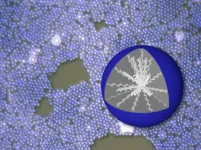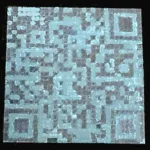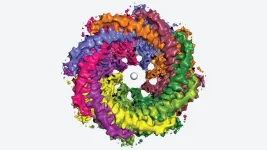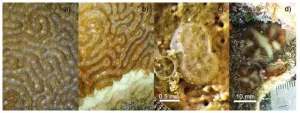(Press-News.org) A research group led by Dr. Jialei He of Nagoya University's Graduate School of Engineering has developed a method for processing cholesteric liquid crystals (CLCs) into micrometer-sized spherical particles. CLCs are a type of liquid crystal that possess a helical structure, giving them unique optical properties and the ability to selectively reflect light. By combining spherical CLC particles with commercially available pigments, the researchers developed a unique anti-counterfeiting QR code that can only be displayed under a specific circular polarizer. The results were published in the journal Advanced Optical Materials.
CLCs are an example of how nature can be used in engineering. If you have ever noticed the iridescent wings of butterflies or the glossy coating on the exoskeletons of beetles, you have seen what CLCs can do. Once identified, CLCs that mimic the units that generate the colors of the exoskeletons of beetles are synthesized in the laboratory because of their unusual colors and properties, which lie between liquids and crystals.
Particularly useful are the optical properties of CLCs. They display unusual colors due to their unique molecular structure and optical properties that lead to the selective reflection of light at specific wavelengths. CLCs consist of long molecules that repeat themselves in the shape of a helix. In the helix, the vertical distance from where one region loops around and repeats itself is called the ‘pitch’. If the helix has repeating units that are close together, the liquid crystal has a short pitch and reflects shorter wavelengths of light, giving off blue and violet colors. However, those with a longer vertical space have longer wavelengths, leading to red or orange colors.
To complicate matters further, because the molecules that make up the crystal are arranged in a helix, the color can change depending on the viewer's orientation to the helix. Therefore, an infinite number of colors are possible depending on how the liquid crystal is viewed.
To utilize CLCs more effectively, researchers make spherical CLC particles. These particles are spherical and include the helix in a 3D matrix so that scientists can better control their coloration. However, a major problem is size. Current methods create 100-micrometer spherical CLC particles, which is too large for most uses. To tackle this problem, researchers Jialei He (he/him) and Yukikazu Takeoka (he/him) from Nagoya University and their colleagues used a mixture of solvents to create spherical CLC particles with a controlled particle size of a few micrometers using a technique called dispersion polymerization.
Since the samples were taken at room temperature, discovering the new technique was difficult. “The sample testing was a particularly challenging time due to the softness of the samples at room temperature, which is a property inherent to CLCs,” said Dr. He. “Consequently, a considerable amount of effort was required to find an appropriate method to characterize the samples without causing any damage.”
Since the pitch of the cholesteric liquid crystal of spherical CLCs particles of this size varies with the curvature of the particles, the researchers made the particles spherical with a uniform size distribution. This is known as a monodisperse sphere. “During the experiment, we unexpectedly discovered that the particle size of the microspheres significantly influenced the resulting structural color. We could produce a variety of colors depending on particle size,” said Dr. He. “We also found that covering the spherical CLC particles with the polymer polydimethylsiloxane improved the coloration and thermal stability.”
One potential application for this research is the creation of more secure QR codes that cannot be replicated. They could be created by taking advantage of a feature of the CLCs called chirality. Chirality refers to the property of an object or molecule that it cannot be superimposed onto its mirror image because of an asymmetry. CLCs are chiral and have optical activity, so an anti-counterfeiting QR code could be created by combining the color of spherical CLCs particles with commercially available non-chiral pigments. The code could only be read when a specific circular polarizer that allows the non-chiral light through but not the chiral light of the QR code is used..
“The development of spherical CLC particles development resulting from this research will provide new possibilities for low-cost structural color functions different from those of conventional color materials,” said Dr. Takeoka. “As well as being used a special functional pigment for anti-counterfeiting, it can also be used for other applications that take advantage of the circularly polarized structural color with little angle dependence.”
END
Liquid crystals that mimic beetle shell coloration units used to create more secure type of QR code
2023-07-14
ELSE PRESS RELEASES FROM THIS DATE:
ROSE: a revolutionary, nature-inspired soft embracing robotic gripper
2023-07-14
Ishikawa, Japan -- Although grasping objects is a relatively straightforward task for us humans, there is a lot of mechanics involved in this simple task. Picking up an object requires fine control of the fingers, of their positioning, and of the pressure each finger applies, which in turn necessitates intricate sensing capabilities. It’s no wonder that robotic grasping and manipulation is a very active research area within the field of robotics.
Today, industrial robotic hands have replaced humans in various complex and hazardous ...
Study shows surprisingly low use of COVID antiviral treatments in nursing homes
2023-07-14
Nursing homes were a key battleground during the COVID pandemic and prioritized for distribution of PPE, vaccines, and COVID testing kits. However, new research shows that monoclonal antibodies and oral antiviral drugs were not used in these facilities as much as would be expected given the high-risk of resident populations.
Brian McGarry, PhD, with the University of Rochester Medical Center, and collaborators at Harvard University, authored the new study, which appears today in JAMA. The authors examined data compiled ...
This eight-armed octopus-like pore detects taste
2023-07-14
The neurons in our bodies are dotted with tiny pores that let essential molecules pass in and out of our cells. Neurons need these channels to send the signals that allow us to move, think, and perceive the world around us. Now, structural biologists at Cold Spring Harbor Laboratory (CSHL) have captured never-before-seen images of one of the largest pores in human neurons. It’s called calcium homeostasis modulator protein 1, or CALHM1 for short.
Previous studies have shown that mutations in the Cahlm1 gene may be a risk factor for Alzheimer’s disease. CSHL’s new ...
New study demonstrates the potential of diseased coral parents in restoring stony coral tissue loss disease-affected species
2023-07-14
Stony Coral Tissue Loss Disease (SCTLD) has wreaked havoc on coral reefs across the Caribbean, resulting in significant mortality of various coral species, including Pseudodiploria strigosa, which has been particularly affected in the Mexican Caribbean. In response to the decreased abundance and colony density caused by SCTLD, scientists have explored larval-based restoration methods, despite concerns about disease transmission. A new PeerJ Life & Environment study reveals that even colonies affected by SCTLD can play a vital role in the assisted sexual reproduction for the restoration of SCTLD-susceptible species.
The ...
Owning a pet does not reduce symptoms of severe mental illness, study shows
2023-07-14
Living with and having a close bond with a companion animal does not necessarily lead to significant mental health improvements in people with a serious mental illness, say researchers.
A survey, conducted by the University of York, revealed that living with an animal - a dog, cat, fish or bird for example - did not improve wellbeing or reduce depression, anxiety or feelings of loneliness for owners with serious mental illness, such as bipolar disorder or schizophrenia, compared to those who live without an animal.
The researchers, who followed up on an earlier survey conducted in 2021 on investigating aspects of animal ownership and mental ...
AI brings hope for patients with lyosomal storage disease
2023-07-14
Artificial intelligence is becoming increasingly important in drug discovery. Advances in the use of Big Data, learning algorithms and powerful computers have now enabled researchers at the University of Zurich (UZH) to better understand a serious metabolic disease.
Cystinosis is a rare lyosomal storage disorder affecting around 1 in 100,000 to 200,000 newborns worldwide. Nephropathic (non-inflammatory) cystinosis, the most common and severe form of the disease, manifests with kidney disease symptoms ...
Pets do not significantly benefit the emotional health of owners with severe mental illness, study shows
2023-07-14
A new study published in the CABI journal Human-Animal Interactions suggests that companion animals – including dogs, cats, fish and birds – do not significantly benefit the emotional health of owners with severe mental illness.
Results showed that owning an animal was not significantly associated with the wellbeing, depression, anxiety or loneliness scores for owners with a range of severe mental illnesses such as bipolar disorder or psychosis.
The researchers, who followed up on an earlier survey conducted ...
Scientists knit futuristic eco-building designs using fungal networks
2023-07-14
Scientists hoping to reduce the environmental impact of the construction industry have developed a way to grow building materials using knitted molds and the root network of fungi. Although researchers have experimented with similar composites before, the shape and growth constraints of the organic material have made it hard to develop diverse applications that fulfil its potential. Using the knitted molds as a flexible framework or ‘formwork’, the scientists created a composite called ‘mycocrete’ which is ...
Ketamine effective for treatment-resistant depression: clinical trial
2023-07-14
A low-cost version of ketamine to treat severe depression has performed strongly in a double-blind trial that compared it with placebo.
In research published today in the British Journal of Psychiatry, researchers led by UNSW Sydney and the affiliated Black Dog Institute found that more than one in five participants achieved total remission from their symptoms after a month of bi-weekly injections, while a third had their symptoms improve by at least 50 per cent. The study was a collaboration between ...
Welcome, Big Tuna! New commanding officer takes command at the Office of Naval Research Global
2023-07-14
The Office of Naval Research (ONR) Global, ONR’s international arm, welcomed new leadership today, as Capt. Andy “Big Tuna” Berner was sworn in as the new ONR Global commanding officer during a ceremony at Naval Air Station Patuxent River, Maryland. Berner takes over for Capt. Matthew Farr.
Chief of Naval Research Rear Adm. Kurt Rothenhaus served as presiding officer of the change-of-command ceremony, as well as presenter of awards.
“Learning from our partners and allies ...






